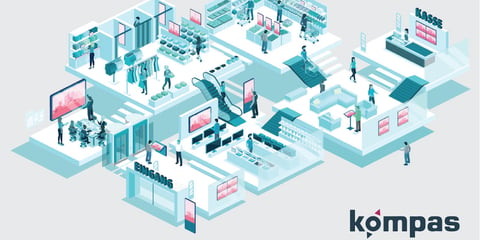Retail Digital Signage: What Works?
The digital transformation of stationary retail is in full swing and digital signage is an essential part of an omnichannel approach. Why is that? Because before we get into the dos and don'ts, traders should ask why.
What is digital signage?
 Digital signage refers to the use of digital media content in retail in advertising and information systems such as electronic posters, electronic traffic signs, advertising in shops (in-store marketing), digital door signs or large-screen projections. Digital signage is increasingly being used in public spaces such as train stations, airports, retail and shopping malls. The technical solution is the instore marketing software.
Digital signage refers to the use of digital media content in retail in advertising and information systems such as electronic posters, electronic traffic signs, advertising in shops (in-store marketing), digital door signs or large-screen projections. Digital signage is increasingly being used in public spaces such as train stations, airports, retail and shopping malls. The technical solution is the instore marketing software.
What exactly does digital signage do at the POS?
Bridging the gap between online and offline shopping experiences
Reduces purchase cancellations and strengthens customer loyalty
Enables intelligent product control based on inventory (Smart Stocking)
Increases sales
Creates ambience
These goals can only be achieved in retail if you think carefully about and plan your digital signage project. The technical article here would like to provide concrete help for this. Basically, before every implementation there is a concept and an analysis of the requirements on site. Who are my customers? What communication problems do I want to solve with my digital signage installation? What are my goals?
Which does not work
From our experience, there are common mistakes that lead to unsatisfactory results:
Insufficient digital signage software
The following applies here: the goals and target groups determine the content and formats, and these must be implemented using the right software. Do I want to use my digital signage software to do more than "just" show advertising, such as offering interaction or integrating customers' smartphones? Then I have to find the appropriate hardware and software that can do it!
Working without an editorial plan
Hardware and software (instore marketing software) form the infrastructure. Many plan the system in detail, but forget to plan budget and staff for the editorial work for the digital signage magazin. And if the budget is there, then content and campaigns should be long-term and part of a comprehensive communication plan.
Wrong locations for screens
Bad places are those where you don't come into contact with the retail customers. A wrong location is already a wrongly chosen height: for evolutionary reasons we look down at an angle of 15 degrees, so anything hanging over 2.20 meters is only rarely noticed.
Too much content on one screen
Like the analog poster, the digital signage and digital signage magazine is a visual communication tool that works primarily through short and simple messages. A picture, a statement. If the screens are overloaded, the messages are lost. It is also a mistake to copy PDFs and PowerPoint slides one to one. Digital signage lives above all from movement, so it is advisable to use a lot of moving images, whether videos or animations.
Unprofessional hardware
A common mistake in digital signage projects is the use of non-professional hardware. For example with the screens: are they designed for 16 or 24 hours of operation? Flat screens for the consumer sector in retail are not suitable for this! Other aspects: Ensuring the functional guarantee (maintenance, alarm systems), certified hardware is better positioned here. Optimized rollout management is just as important a topic as consistently high hardware quality and long-term availability from the manufacturer so that defective devices can be replaced in a few years.
No integration of merchandise management
A good digital signage solution today should do more than just display content and broadcast it on screens - it must be able to process dynamic data that is obtained from other software solutions, such as inventory management, weather and traffic data. But information from sensors is also becoming increasingly important. A contemporary digital signage software intrigues RFID as already known in trade and retail, for example to set a trigger for a change of content. If a customer picks up a product, the software recognizes this and plays suitable content.
Non-Dynamic Content
A special advantage of digital signage is the use of current, dynamic data such as social media content and statistics from databases, which are then played out locally. This is relevant content and also reduces editorial effort.
 Interactive digital signage to improve customer loyalty
Interactive digital signage to improve customer loyalty
Non-relevant content for the target audience
A digital signage system will fail if the content is not relevant to the target groups. Therefore, make sure to create a concept beforehand!
Digital signage as an isolated solution, without interfaces
A mistake that is unfortunately often encountered: digital signage is planned and implemented as an isolated solution. This is not only about the lack of integration into an existing IT infrastructure, but above all and the content and conceptual integration. Digital signage is "only" a component of a communication strategy and must therefore be planned in terms of integrated communication.
If you avoid these common mistakes, a lot has already been gained and the digital signage system in trade and retail can achieve the goals. There is good knowledge and experience about what works particularly well and is accepted by customers in retail:
- Digital technologies as helpers in consultations - smart and effective
- Integration of smartphones for customers and employees: Appropriate product presentation at the push of a button.
- Lift&Learn: Raise the product - play suitable content - sell emotionally.
- Product finder and configurator: inspire and sell.
- Directions: Orientation guide for customers - market research tool for retailers.
- Scan product, print out information: find out more, sell better.
- Plan targeted digital signage campaigns with automated algorithms: Efficiently control inventory thanks to Smart Stocking.

Example of successful digital signage in retail: With Lift&Learn, the screen plays specific content as soon as a customer lifts a product. (Source: Peakmedia/dimedis)
Conclusion: digital signage works!
Numerous studies show that moving images have a better effect and are more likely to be perceived than static images. A big plus of digital signage, which always gets top marks among all advertising and information formats. If you avoid the mistakes and do it right, digital signage fills the data gap in stationary trade and retail and helps to better fulfill the promise of an omnichannel approach. Well-implemented digital signage reduces purchase cancellations and strengthens customer loyalty, digital signage is therefore part of the added value.




